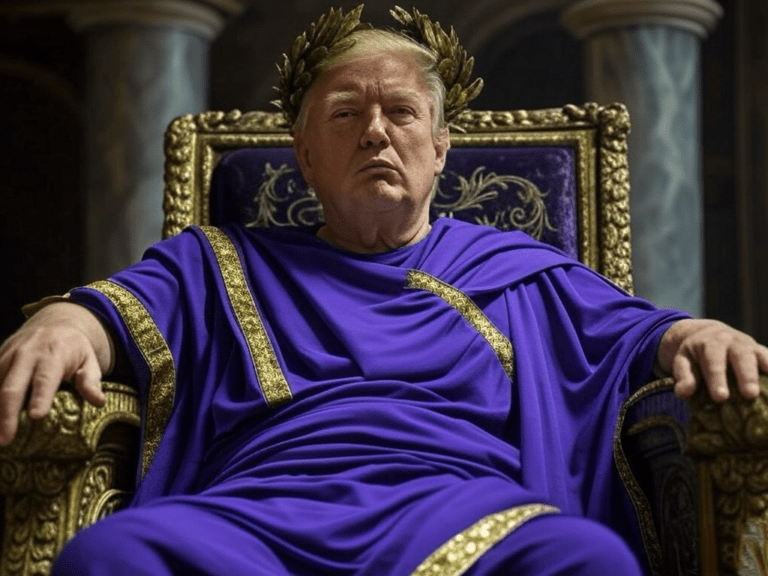
A Republic Unraveled
In the glare of noon’s unyielding blaze,
A spectre marches through the haze.
With gilded hands and brazen grin,
He tears the guardrails from within.
The courts, the codes, the sacred ties,
Distorted now by crafted lies.
The gavel cracks; its echoes fade,
While justice slips into the shade.
Blindfold tattered, scales untrue,
What once stood firm now bends askew.
The law, a fragile woven thread,
Unravels fast ‘neath boots of dread.
The watchmen falter, spines unsteel,
Their oaths dissolve, their voices kneel
And pillars crumble, one by one,
Beneath the weight of what he’s done.
What oath remains when truth goes blind?
What torch will guide the weary mind?
A republic gasps; its lifeblood drains
As daylight smirks at shattered chains.
But though the dark invades the land,
Hope lingers still with trembling hand.
For shadows flee where fire burns bright –
The people must reclaim the light.
🖊️ Bakchos
Abstract
The decline of the Roman Republic and the emergence of Augustus as Rome’s first emperor mark a pivotal moment in history, characterised by political scandals, populist agitation, and the erosion of republican norms. Similarly, Donald Trump’s presidency (2017–2021) has been viewed by some as a stress test for American democracy, marked by controversy, institutional challenges, and a polarising leadership style. While the contexts differ vastly – Rome’s agrarian oligarchy versus America’s modern constitutional republic – parallels can be drawn in how both periods reflect the vulnerabilities of republican systems to ambitious individuals, factionalism, and public discontent. This paper examines these similarities and differences, focusing on scandals, populist tactics, and the aftermath of each leader’s tenure.
Introduction
The fall of the Roman Republic and the rise of Augustus represent a significant transformation in governance, one that resonates with contemporary discussions surrounding the integrity of democratic institutions. The political landscape of both ancient Rome and modern America has been shaped by ambitious leaders, societal divisions, and the manipulation of public sentiment. This paper seeks to explore the parallels between the political climates of Donald Trump’s presidency and the late Roman Republic, culminating in the rise of Augustus, to better understand the mechanisms through which republics can falter and the implications for modern governance.
Scandals and the Erosion of Trust
The Late Roman Republic
The late Roman Republic was plagued by numerous scandals that undermined its political institutions and eroded public trust. The First Triumvirate (60 BCE), an informal alliance between Julius Caesar, Pompey, and Crassus, exemplified the bypassing of traditional senatorial authority for personal gain. This period was marked by political machinations that prioritised individual ambition over the common good. Caesar’s crossing of the Rubicon in 49 BCE, an act of defiance against the Senate, escalated into civil war, signalling the fragility of the Republic. Earlier, the land reforms proposed by the Gracchi brothers (133–121 BCE) incited violence and exposed deep-seated class tensions, while figures like Catiline (63 BCE) exploited economic despair to plot coups. These scandals collectively eroded civic trust, paving the way for Augustus to consolidate power under the guise of restoring stability.
Trump’s First Presidency
Donald Trump’s presidency was similarly rife with controversies that strained democratic norms and institutional integrity. The Mueller investigation (2017–2019) into Russian interference in the 2016 election cast a shadow over his legitimacy, though it ultimately found no conclusive evidence of collusion. The 2019 impeachment, which centred around Trump’s pressure on Ukraine to investigate a political rival, echoed Roman accusations of ambitus (electoral corruption). Furthermore, the January 6, 2021, Capitol riot, incited by Trump’s refusal to accept electoral defeat, serves as a modern parallel to Caesar’s defiance of republican authority, although Trump did not seize power militarily. Both periods witnessed scandals weaponised by opponents and supporters alike, deepening societal divides and weakening faith in institutions.
Trump’s Second Presidency: Aggressive Expansion of Power
As Trump began his second term in January 2025, he swiftly moved to consolidate power. By mid-February 2025, he had signed 66 executive orders, alongside multiple proclamations and memoranda addressing immigration, energy policy, and federal workforce regulations. This rapid issuance of executive orders raises alarms regarding the bypassing of Congressional authority.
Notable Actions
Ending Birthright Citizenship: An executive order aimed to deny citizenship to children born to undocumented immigrants, challenging the 14th Amendment. This action is likely to face legal challenges, testing the judiciary’s ability to uphold constitutional rights.
National Energy Emergency Declaration: Trump declared a national emergency to expedite drilling operations, potentially circumventing environmental regulations. This move exemplifies executive overreach and could lead to significant legal battles.
Ignoring Congressional Directives: Plans to reduce the federal workforce and eliminate agencies such as the Department of Education indicate a willingness to disregard Congressional spending laws, which undermines legislative authority.
Congressional and Judicial Responses
The effectiveness of the checks and balances system hinges on the responsiveness of Congress and the judiciary. With a Republican-controlled Congress, there is a risk that legislative oversight may diminish, allowing Trump to advance his agenda with little resistance. The Supreme Court’s conservative majority, influenced by Trump’s appointments, raises further concerns about the judiciary’s willingness to challenge executive actions.
Historical Precedents
Historically, courts have intervened to check presidential power, as seen with challenges to Trump’s travel ban during his first term. However, the current political climate suggests that judicial responses may be muted, particularly in the face of partisan alignment.
Expert Analyses and Risks
Scholars and legal experts have expressed concerns about the potential collapse of checks and balances under Trump. David M. Driesen, in his essay “Donald Trump and the Collapse of Checks and Balances,” argues that the decline in Congressional willingness to check executive abuses is likely to worsen in a second term. This analysis underscores the risks of cumulative executive overreach, where multiple challenges to the system could overwhelm judicial capacity.
Populism and the Appeal to the Masses
Roman Populism
A key similarity between the two political climates lies in the populist strategies employed by Trump and the Roman figures preceding Augustus. The Gracchi brothers rallied the plebeians against the elite Senate, promising land and grain, while Julius Caesar cultivated loyalty among soldiers and the urban poor, positioning himself as their champion against a corrupt aristocracy. Augustus, inheriting this legacy, framed his rule as a restoration of the Republic, despite dismantling its democratic elements. These leaders effectively exploited public grievances – economic inequality, perceived elite overreach – to justify extraordinary measures.
Trump’s Populist Rhetoric
Trump’s rhetoric mirrored this populist approach. Campaigning as an outsider, he attacked the “Washington swamp” and media elites, resonating with voters disillusioned by globalisation and cultural shifts. His promises – building a border wall, reviving manufacturing – echoed the Gracchi’s tangible pledges to the disenfranchised. Like Caesar, Trump thrived on personal loyalty, evident in his rallies and direct communication via Twitter, allowing him to bypass traditional media gatekeepers. However, unlike Augustus, Trump did not transition to autocracy; America’s constitutional checks – courts, Congress, and elections – remained intact, albeit under significant strain.
Institutional Responses and Outcomes
The Roman Senate’s Failure
The institutions of the Roman Republic proved too brittle to withstand the pressures exerted by ambitious leaders. The Senate, weakened by corruption and factionalism, was unable to resist Caesar’s military might or Augustus’ subtler consolidation of power. Augustus’ Principate (27 BCE) retained republican facades – elections, the Senate – while centralising power, effectively ending the Republic in all but name. This outcome reflected Rome’s lack of a written constitution and reliance on custom, which could be easily subverted by determined actors.
The Resilience of American Institutions
In contrast, the American system demonstrated a greater resilience in the face of challenges posed by Trump’s presidency. The U.S. Constitution, with its separation of powers, constrained his ambitions. The judiciary blocked various policies, such as the initial travel ban, while Congress resisted some of his budgetary demands. The 2020 election ultimately removed him from office despite his persistent claims of electoral fraud. Yet, the Capitol riot and ongoing disputes over election legitimacy revealed vulnerabilities, raising questions about the durability of democratic norms against charismatic disruption. Unlike Rome, America’s republic endured significant challenges, maintaining its constitutional framework, though not without scars.
Key Differences and Contextual Nuances
Despite these parallels, significant differences temper the comparison. Rome’s Republic was an oligarchy with limited suffrage, prone to violence as a political tool – e.g., the murders of the Gracchi or Caesar’s assassination. America’s broader democracy, underpinned by legal frameworks and a free press, offers greater accountability. Trump’s scandals, while disruptive, lacked the existential stakes of Roman civil wars; his departure in 2021 was peaceful, if contentious, unlike the bloodshed preceding Augustus.
Moreover, Augustus achieved lifelong rule, crafting a monarchy disguised as a republic. Trump, bound by term limits and electoral defeat, left office, suggesting a fundamental resilience absent in Rome. The Roman transition was permanent; America’s remains contested but intact as of October 2023.
Conclusion
The scandals of Trump’s presidencies and the fall of the Roman Republic highlight how republics falter under factionalism, populism, and institutional erosion. Both periods saw leaders exploit public discontent, challenge established norms, and provoke crises of legitimacy. However, while Rome succumbed to autocracy under Augustus, America’s system withstood Trump’s tenure, albeit with lingering divisions. These cases underscore a timeless lesson: republics endure not through inertia, but through the vigilance of their citizens and the strength of their institutions. For Rome, that strength failed; for America, it has – so far – prevailed.
References
• Beard, M. (2015). SPQR: A History of Ancient Rome. Liveright Publishing.
• Carlin, D. (2020). The Rise and Fall of the Roman Republic. Routledge.
• Trump, D. J. (2017-2021). Presidential Statements and Social Media Posts. White House Archives.
• Weigel, G. (2021). The Fragility of Freedom: How the American System Endures. Basic Books.

